12 Feb Ecuador — Doctor Hoatzin, I presume
“Don’t go to Cuyabeno” the travel company said. “The Indians down there are restless.
“We don’t get a kickback from the people down there,” is what Peggy and I heard. And found a more amenable travel company.
Still, there may have been something to that Indian thing . . . although I don’t think they were so much restless as pissed off. Twenty years earlier they’d filed a class action against Texaco for polluting their jungle and the case went all celebrity. Mia Farrow got involved. Sting got involved. Cher put in her two-cent’s worth, for whatever that was worth. The Indians won an 18 billion dollar judgment in Ecuador . . . then saw it overturned by the International Permanent Court of Arbitration in the Hague on account of the corruption at trial, which included perjury, bribery, corruption and the fact that three of the cancer victims didn’t have cancer. The main defense witness pocketed an undisclosed amount of oil-company money, changed his name, and disappeared. Plaintiff’s lead US attorney had his license suspended for paying almost $300,000 in bribes. Huffington Post used the word “genocide,” Amnesty International got involved and Bill Clinton paid Mickey Kantor, his former US Trade Representative, to convince President Obama to revoke Ecuador’s favored trade status if they didn’t drop the case. It doesn’t take Margaret Mead to see why the locals had their dander up.
To get to Cuyabeno, you fly from Quito down the back side of the Andes to Nueva Loja, take a bus forty-five minutes to a bridge
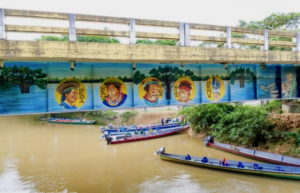
over, naturally enough, the Cuyabeno River, and wait for a boat to take you downstream.
It was February, the rainy season had just ended, and the Cuyabeno still had enough water to qualify as a river. But barely. There were bars to not run aground on, and sunken logs to swing around, branches to duck, toucans, parrots, monkeys and wading birds
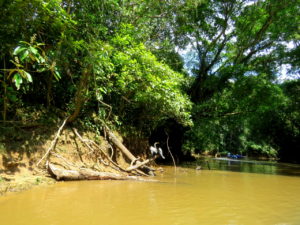
to admire, and caimans to worry about. The river turned, then turned again, and back on itself and, had it been a few inches lower, we’d have ripped the bottom out of the boat. Or gotten mired in quicksand. Or slammed to a stop so quickly against a stump we’d have hurtled into the mouth of a caiman. I’d have pictures but I was too busy hanging on.
Toward evening, the river debouched
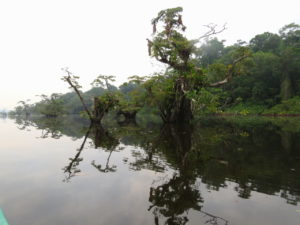
into an endless expanse of flooded forest and, half-an-hour later, we came to the place we’d be staying.
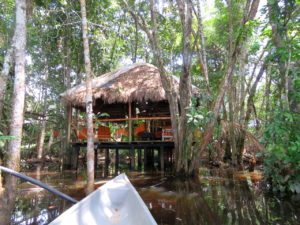
It was a place where solar panels supplied enough electricity to run the lights for four hours after sunset with juice left over to power the cooler that kept very large bottles of beer very cold. The whole operation was so environmentally friendly it was owned by the very Indians the travel company warned us about.
This being Ecuador, we could hike a few hundred yards into the jungle to where they kept the equator
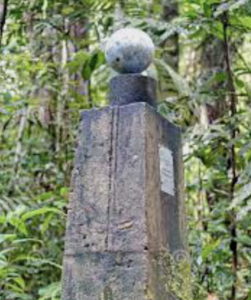
on a weathered concrete monument, then cross over to the Northern Hemisphere and cool off for a while in winter.
Late afternoons, we’d boat to the deepest part of the flooded area and jump in.
“Don’t worry about caimans,” the guide informed us. “They don’t come this far out.”
Maybe, we thought, but people have been swimming here for a long time, caimans look a lot like crocodiles, and crocs are quick studies. In Africa you never swim in the same place twice.
Pink dolphins, he gave us to understand, have the same attitude toward caimans that saltwater dolphins have toward sharks, and caimans stay close to shore to keep from being butted to death.
Now that he mentioned it, there did seem to be a sort of rippling
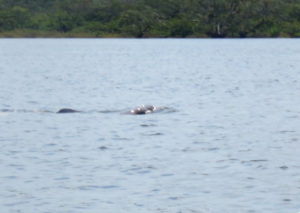
off in the distance where a dolphin was playing with a stick. Pink dolphins spend hours playing with sticks and, when a male finds a particularly likely stick, he presents it to a pink lady. Male pink dolphins are nothing if not courtly.
Mornings, half an hour before sunrise, Peg and I would join one of the guides and canoe out among the trees. The excuse was to look for birds,
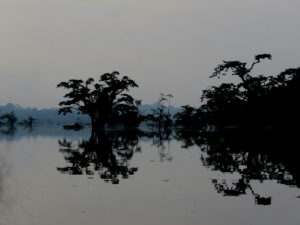
but really, we just wanted to be on the water. In the gray light before dawn, the forest had an almost hallucinatory
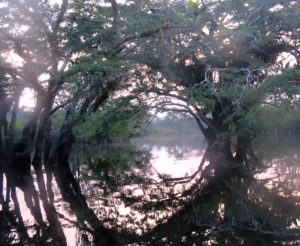
in its beauty.
As the sun rose,
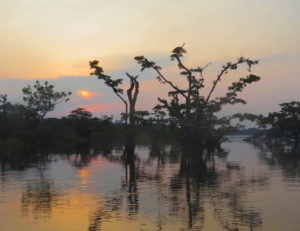
the trees filled with sounds
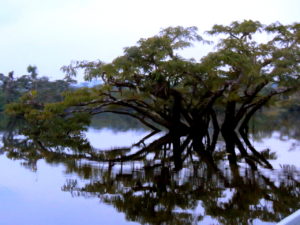
of birds. Many, many birds.
I’ve been shooing birds away from this account because when you start mixing birds and tropical Ecuador, there’s no end to it. Tolstoy would run out of pages before he ran out of birds to write about. But Tolstoy never saw a hoatzin.
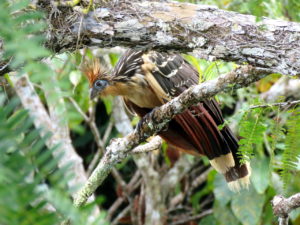
Hoatzins are dinosaur birds who still carry enough lizard DNA that their chicks hatch with claws on their wings so they can climb around in trees, and I’d wanted to see one for as long as I’d known about dinosaurs. And hoatzins.
As we’d head back to the dock the forest would fill with sunlight
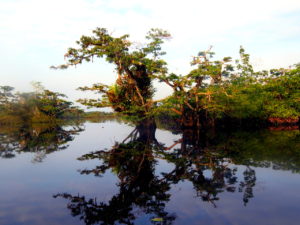
and individual trees
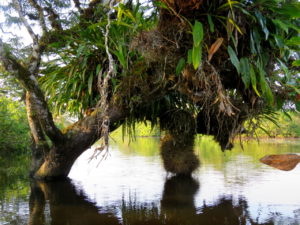
looked as ancient and displaced in time as the hoatzins that scampered in their branches.
When time came to leave Cuyabeno, we set out at 3:30 in the morning in a boat operated by a kid who should have been home getting a good night’s sleep before heading off school. The moon was a couple of days past full and glistened from the water as we motored along the edge of the flooded area
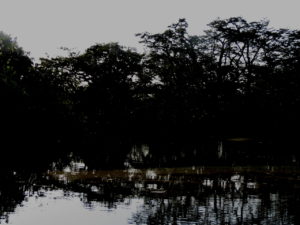
the jungle dark and unknowable beside us.
Half an hour after we set out, the kid swung the boat toward the shadowiest part of the jungle and into the mouth of the Cuyabeno. Even by moonlight we could tell the river had dropped several inches.
He gunned the motor and, spinning the tiller, sent waves crashing onto the bank, dodged sandbars stretching most of the way across the channel, rooster-tailed around logs Peg and I could barely discern in the dark, skimmed past sinister-looking stumps, shot beneath branches whipping the air above our heads and, at dawn, puttered to a stop at the Cuyabeno Bridge. Where we were met by a driver to take us cross-country to the Napo River.
His pickup was older, and had endured more than you’d think possible for a truck that could still move so fast. And it didn’t have seat belts. We bounced along for a couple of hours, spinning around potholes as if we were still still speeding up the Cuyabeno, then came to a stop at a little cafe where an unexplained lady climbed in. Followed by an unexplained kid. And shot back onto the road, the uneven surface making little flapping sounds under our wheels.
An hour or so later, the driver mentioned something, Unexplained Lady leaned out the window, mentioned something back and, after another ten minutes or so, we lurched to a stop. The flapping noise was the front, right tire disintegrating.
The driver lifted the baldest spare Peg and I had ever seen out of the bed of the truck, replaced the disintegrated tire, and, off we went, Unexplained Lady riding shotgun with Unexplained Kid riding airbag on her lap. Until we came to a town and she shoved Unexplained Kid onto the floor
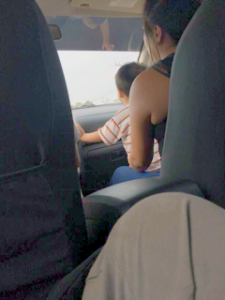
where the police wouldn’t notice and she wouldn’t have to explain anything.
Hours later, they dropped us off at the foot of a statue of Francisco de Orellana Bejarano Pizarro y Torres de Altamirano . . . a man whose ambitions were as big as his name . . .
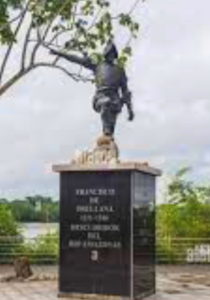
arm pointing heroically downriver. I’d heard about Orellana. I’d even read his account. He’d set out from that very spot to lead the first expedition down the Amazon to the Atlantic. If it weren’t for him, none of us would ever have known about the advanced civilizations that once lined the river. Because by the time the next outsiders arrived, they were completely gone. Wiped out, most likely, by the diseases Orellana and his men brought with them.


No Comments